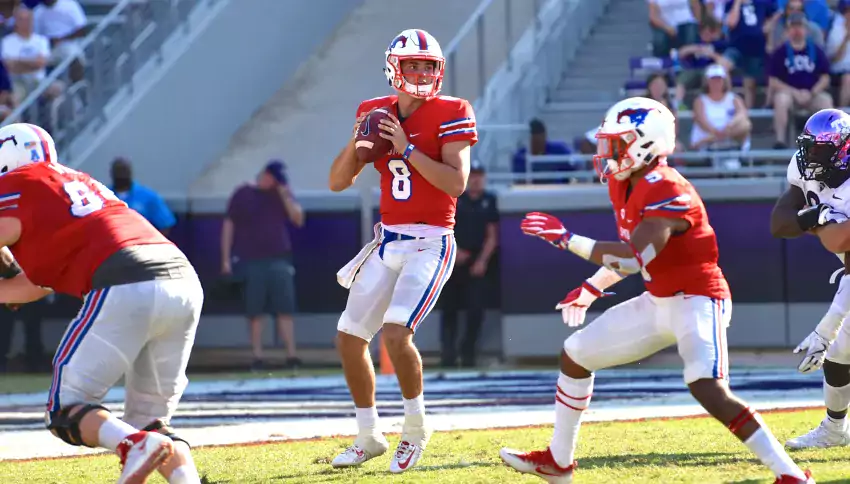
Fee Fi Foe Film: SMU Offense 2018

Last year's TCU game [Bryan Fuller]
The film: It's wet. Our options were SMU versus a Top 15 TCU in the pouring rain after a two-hour weather delay, or their 46-23 opening loss to North Texas in which the Mustangs didn't score until garbage time. I went with the more recent 42-12 loss to TCU because Garbage Time came later—SMU got a big run and a safety to stake a 9-0 lead in the 1st quarter, and didn't fall more than two trips behind until early in the 4th. But it was awfully wet. The conditions had a major effect on ball security and accuracy. So did TCU's defense. So did the Stangs.
Personnel: My diagram
(here's a PDF version or click the image to open a full-size version)
I cyan'd left guard Nick Natour, a returning starter who was a constant source of issues, and right tackle Larry Hughes, a Kansas transfer who made me feel incrementally better about Michigan's pass blocking. Cyans and stars are relative, or else the center Hayden Howerton, and the right guard, Jacob Todora probably deserve them as well. When Sonny Dykes has had enough of his interior line's Three Sieves routine, he'll pull one of the guards for JUCO transfer Nick Dennis, who's listed as an "OR" with Todora, but starts on the bench for good reason. There's nothing they can do about the KU transfer except to line him up as wide and far into the backfield as the day's refs will allow, and stick a tight end next to him.
SMU would clearly prefer to play with "20" (2 backs) or "10" (4-wide) personnel, but will have a TE on the field 60% of the time. I actually really liked the Flex guy, Ryan Becker, but not the H-back type, Hunter Thedford. The rest of the skill position guys I'll discuss in the Overview.
Spread, Pro-Style, or Hybrid: Spread to the max. Most of the time they're in a short Pistol with the RB just a yard off. Also note the spacing of the linemen (in a rare two-TE set):
They set up arm's length apart and the guards line up as far in the backfield as most teams' offensive tackles. These spreads are part of the Air Raid offense: the wider gaps make for more space to run, and create a longer path to the quarterback for exterior pass rushers. The tradeoff is it's more space for the interior OL to lose a block, and these interior OL will do that a lot. The spacing problems and the lack of awarenes and athleticism were especially apparent when TCU went to a 3-3-5 and blitzed inside gaps with faster linebackers. If there's one player in college football that SMU's offense would not want to face this year, it is Devin Bush Jr. Fortunately for them there are 130 FBS teams and just 12 games to play, so there's less than a 10 percent chance of…nevermind it's happening.
[After THE JUMP: Maybe it'll rain again]
------------------------------
Basketball on Grass or MANBALL? Manball on grass? Is that a thing? Having the guards line up in the backfield lends itself to power. They also run a lot of Zone Reads and RPOs. Charts:
| Formations | Run | RPO | PA | Pass |
|---|---|---|---|---|
| Gun & Pistol | 22 | 12 | 4 | 32 |
| Run Type | Runs | RPOs | Total |
|---|---|---|---|
| Zone Reads | 12 | 12 | |
| Power | 3 | 4 | 7 |
| Inside Zone | 5 | 5 | |
| Sweeps/Pitches/Shovels | 4 | 1 | 5 |
| Unbalanced Jet Package | 2 | 1 | 3 |
| Draw | 1 | 1 | |
| Split zone | 1 | 1 | |
| Total | 22 | 12 | 34 |
Like last week the zone read is the base play but the quarterback isn't a big threat on the ground. However the pass-run ratios are a little bit more in line with what they probably want to run against Michigan, i.e. an Air Raid passing game. A quarter of comeback mode offsets the half when throwing into the rain was asking for funky (read: bad) things to happen.
| Down | Run | RPO | PA | Pass |
|---|---|---|---|---|
| 1st | 13 | 5 | 4 | 6 |
| 2nd | 3 | 7 | - | 12 |
| 3rd & 4th | 6 | - | - | 14 |
(the last drive that starts at 1:30 was not charted)
Hurry it up or grind it out? Average. They'll go Tempo for a drive or two and don't huddle, but they're not a race-to-the-line-and-snap-it team. They'll line up with plenty of time to spare and snap it with about 12 seconds left.
Quarterback Dilithium Level (Scale: 1 [Navarre] to 10 [Denard]): I gave Wassink a generous 3 last week; Ben Hicks is a guy with about the same running ability who thinks he's a 6. He has very little wiggle but he's more interested in running, and that adds some danger. They even have a fake QB draw in the playbook, though this resulted in ZERO safeties stepping forward. He did make a guy miss:
And it was treated as an event. Hicks does have some escapability in the pocket, a useful skill when your line lets a two-man rush get instant pressure.
Zook Factor: Since Les Miles is retired, Sonny Dykes is the new Anti-Zook. Time is all relative. Time is just a fourth axis of three-dimensional space really, when you think about it. Why not ask how much space-time is right on this drive? Infinite.
Dykes's latest clock adventure got SMU points in this one. SMU faced 4th and 1 at midfield, down 14-9 with 1:14 to go in the 1st half. Dykes had two timeouts (TCU had one). First Dykes ran the clock down to 32 seconds and used his timeout. Then they went for it. Then they got it. Then they lined up and threw a quick 7-yard out to get to the 40 yard line. 18 seconds to go. Then they chucked it down the sideline: 13 seconds. Then Hicks kept it and ran for the 1st down, got up, and clocked it. 6 seconds, 32 yard line. Then they threw another quick out, and Proche caught it in his knees and kinda rolled out of bounds. 3 seconds. Kick: good. Sacrifice the last timeout to the turf gods.
I like the call to go for it: if you don't get it TCU's got 30 seconds and a timeout to go the same distance, and you've got the same chance times the likelihood of a 4th and 1 conversion. That's an advantage. If you punt the half's over. That's not to say Dyke's thought process was something other than "Space. Grass. Time. Time is grass."
Dangerman:
A reminder that stars are relative because you always have to point out somebody. The guy they want to get the ball to is the lone returning starter from the receivers. James Proche had 800 yards last year with incredible efficiency. As the main threat this year he's been way less efficient. TCU rarely gave him enough space to turn a short gain into a solid one, but when they did he took advantage:
SMU ran a lot of motion and pick plays to try to get him open against man coverage, and TCU was excellent at not getting stuck on those.
Proche is also a decent blocker on those tunnel screens. However the amount of attention he gets now, and Hicks's bad day of passing, really limited Proche's effectiveness—he had just 4.7 yards per target in this one.
I also liked the catchy-blocky tight end, Ryan Becker. He runs good enough routes that they can have him motion in and out of 4-wide sets, and he was routinely moving guys in the run game.
The running backs are alright. They're a mid-major version of Chris Evans and Karan Higdon where the Evans is actually 25 pounds lighter and used as a receiver and is the starter. That would be Braeden West. He's got that subtle slipperyness that makes for big plays when you don't corral him first.
Also dodging someone immediately is a rather common event because the offensive line forgets to block everyone.
HenneChart:
Ben Hicks was billed as the star of the offense, since he's a returning starter who threw for 3600 yards and 33 TDs last year (also 12 interceptions). It turns out having a pair of NFL-ready receivers is better than not that. Also RAIN, though that became less of an issue as the night wore on. The RPO reads almost always turned into runs but this wasn't a typical night at the Air Show except for 3rd and long. Most of his throws were quick and short. A couple of times they had him try to lob a short fade down the sideline in hopes of drawing PI. I clipped one just for Jane. They didn't work. I filed them under marginal because they missed any plausible window to catch them inbounds, but as far as misses go that's the right place to do so.
| Hicks | Good | Neutral | Bad | Ovr | ||||||||||
|---|---|---|---|---|---|---|---|---|---|---|---|---|---|---|
| Opponent | DO | CA | SCR | PR | MA | BA | TA | IN | BR | DSR | PFF | |||
| TCU | 2 | 11(4) | - | 1 | 5 (1) | - | 4x | 6xxx | 3 | 50% | - | |||
Three bad reads in an Air Raid game aren't that bad—when you and the receivers are trying to execute the same reads sometimes you flub them. That "IN"(-accurate) box should be worrisome for an Air Raid QB though. The rain accounted for some but the safeties were dropping as many balls as his receivers even after things dried up.
Also, yes that's the second "TAx" in FFFF history and of course it deserves to be Witnessed:
Hicks was noticeably rattled by the end of the game. He got the ball out too fast to get hit on a bunch of throws but he was getting hit quite often as the interior pass rush made his pockets bulgy. This time the DTs were stopped, but his first instinct is to run out of there. When he realizes the pocket is the place to be he tries to go back. First rule of pockets, Ben: you can never go back.
OVERVIEW:
Sonny Dykes is a scion of the Hal Mumme Air Raid coaching tree, and his offensive coordinator Rhett Lashlee studied under Gus Malzahn. You can see the Mumme in how they use all available horizontal space, and really stretch the definition of "on the line of scrimmage":

The Malzahn is in the running game, which is based on zone read, power, and RPOs:
This was supposed to be a smooth transition. Dykes replaced Chad Morris, the former Clemson OC (Tajh Boyd era, recruited Deshaun Watson), when Morris took the Arkansas job before the bowl game. The roster Morris left looks like it might have been put together by Sonny Dykes. He's got a ton of tiny receivers who can make plays in space, an experienced Air Raid quarterback in Ben Hicks, and a left tackle who won't get Hick killed, plus returning starters and 22-year-olds.
Through two games however you could be forgiven for thinking there's a major transition cost going on. From the slack chat review of their numbers:
They're bad. The rain didn't help. Save for a bust on the first drive that led to West's TD run above, TCU wasn't much inclined to be helpful either. But the real problem here is 80% of the offensive line often has no idea what they're doing:
The non-left tackle pass protection problems are having an effect on the passing game too, though they're not the only thing to blame, as an actually open receiver more than 4 yards downfield was a rarity. What I think's going on here is the returning slot receiver, James Proche, is a very good role player but is not The Guy. When SMU had a pair of NFL outside receivers last year, Proche was an excellent third banana, with 816 yards and 6 TDs on 61 targets. Take away 2nd rounder Courtland Sutton and "Mr. Irrelevant" Trey Quinn however…
...and you're left with Proche and a bunch of other dudes on the slot-RB spectrum, none of whom can get open consistently. No wonder Proche's average yards per target have dropped by 9 yards.
SMU's answer for replacing 2/3rds of the school's drafted players since 2014 was to add two FAKE inches on the roster to former slot backup Myron Gailliard, and bring in West Virginia grad transfer (yes, nearly half of the guys who get playing time are transfers) Reggie Roberson. While Roberson did play in an Air Raid in Morgantown, it was one that comes more out of the Baylor side of the tree. You can tell he's supposed to be that Read 1 wide receiver—he got 8 targets to Proche's 9 and Gailliard's 4—but only three of those targets got filed as "Catchable" or better, a sign that Roberson and Hicks are not yet on that all-important page.
Another transfer, Notre Dame slot C.J. Sanders, has been mostly a kick returner so far—the backup slot is Tyler Page, a guy I incorrectly guessed was a walk-on, and who's 0 for 6 on his targets this year. SMU would like redshirt freshman Judah Bell, who's actually receiver-sized, to poke through but Air Raid route trees take time to develop, and there's a lot of space left for his to grow.
As with last year, the backs are heavily involved in the passing game, especially West, who will often motion out as a receiver.
#6 in the slot on the bottom
Xavier Jones rotates liberally as more of a feature back. Both have a season of starting, and they'll often put both in the backfield. Third back Ke'mon Freeman will get in here and there as a sub for Jones. All three are involved in the passing game.
Long term, I think SMU's a good fit for Dykes. He's more Texas than California. The hellscape that is the Dallas-Ft. Worth area is crawling with high school Air Raid offenses. And while SMU has an absolutely top-notch archaeology professor who happens to have the same parents as me, admissions is emphatically not going to constantly butt heads with Dykes over transfer credits from Southwest JuCo State like they do at Cal. The program's on its way up. But like the next school we'll preview here, they're catching Michigan way too early.
September 13th, 2018 at 12:11 PM ^
Looking at Larry Hughes, circled in cyan, against Rashan Gary, just has me thinking that poor damn quarterback is going to get decimated early and often. On paper, this game will be over in the first quarter.
September 13th, 2018 at 12:15 PM ^
Don't worry, He'll get to face Winovich sometimes too.
September 13th, 2018 at 2:56 PM ^
I can see Bush and Hudson getting a few, between them, as well
September 13th, 2018 at 12:28 PM ^
Somebody wake up Hicks.
September 13th, 2018 at 1:44 PM ^
Reminds me of the now-defunct and spectacularly-named Cavaliers blog
http://heylarryhughespleasestoptakingsomanybadshots.com/
I was so sorry to see it was gone.
September 13th, 2018 at 12:12 PM ^
Brown won't even have to dial up any blitzes in this game...but, I am sure he will.
September 13th, 2018 at 12:19 PM ^
Professor is your brother from the same mother. Got it.
September 13th, 2018 at 1:27 PM ^
sister, actually.
September 13th, 2018 at 12:43 PM ^
Does anybody else kind of want to wrap Ben Hicks up in bubble wrap right now?
September 13th, 2018 at 12:58 PM ^
Seth:
When you say "Cyans and stars are relative," do you mean relative to the player's own team or viz the opponent? If they're relative to the team the player is on, shouldn't every team have, more-or-less, the same number of stars and cyan circles? If to the opposition, shouldn't some teams have none or a bunch? I always assumed these were somewhat objective and tied to performance against overall expectations of a D1 player.
September 13th, 2018 at 1:34 PM ^
Relative to their team and their competition. But I don't have quotas. If it's a bad unit I'll put a star on any guys I thought were B+ or higher, and I won't hand out cyans unless they're particularly bad. That's because I don't want to just make charts full of cyan guys whenever Michigan plays a team they should beat.
If it's a decent unit, e.g. Iowa's defense, I'll save the stars for the draftable players. Usually a star is in line for all-conference honors. Shields are potential All-Americans.
September 13th, 2018 at 1:07 PM ^
Looking forward to the continued Paye-Winovich-Gary DLs on 3rd downs that popped up against WMU.
That poor, poor QB.
September 13th, 2018 at 1:10 PM ^
Larry Hughes, forever my Wizard
September 13th, 2018 at 1:22 PM ^
We have a lot of experience on defense, so it would be great to get the starters off the field early 3rd quarter. Minimize injury risk and let's get some reps for guys who are going to have to replace people. I was disappointed last week that we didn't see JKP or Ol' Woods (not that I recall). We had Kinnel and Metellus in on the last series of a total blowout. Get the backups in--minimize injury risk and its good for morale.
September 13th, 2018 at 2:29 PM ^
hey ... that was Mettelus's first* game this year. Thanks ND ref's. He needed game action.
Go Blue!
September 13th, 2018 at 3:15 PM ^
Is anyone else getting file not found errors when trying to open the diagram? I get that when trying to open the picture, and a page not found error when trying to open the pdf.
September 13th, 2018 at 3:50 PM ^
Yeah I got the same issue.
September 13th, 2018 at 5:01 PM ^
It's back. Apparently when I try to hide the file I attached to the article it breaks the link as well.
September 13th, 2018 at 4:12 PM ^
"I think you mean Rutger" should be the response every time someone writes or says "Rutgers"
September 13th, 2018 at 9:56 PM ^
SMU is MSU rearranged. Therefore, they gon die.
September 14th, 2018 at 5:57 AM ^
I've always like SMU's helmets. So they got that going for them.
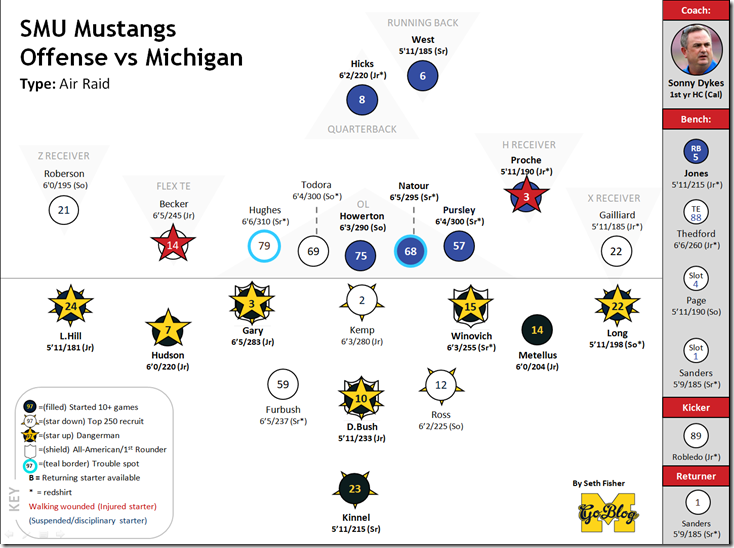
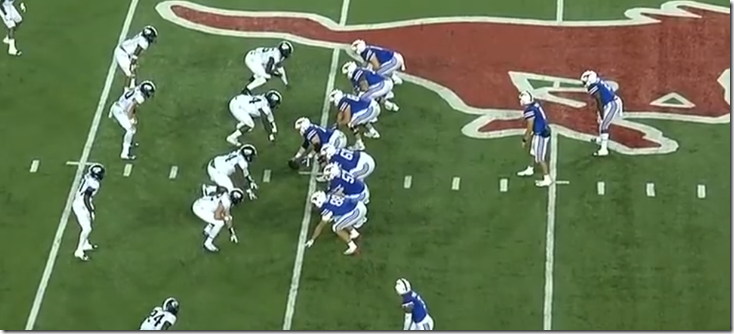
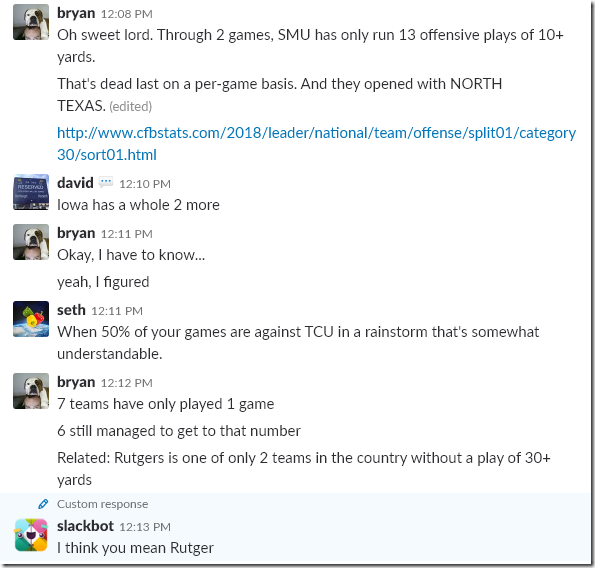
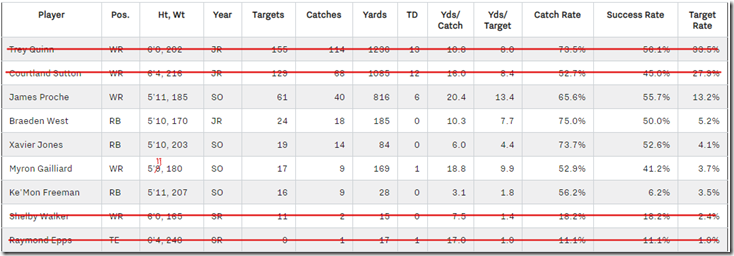

Comments